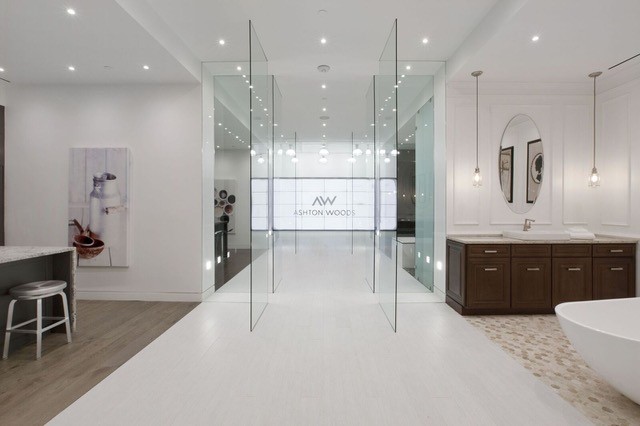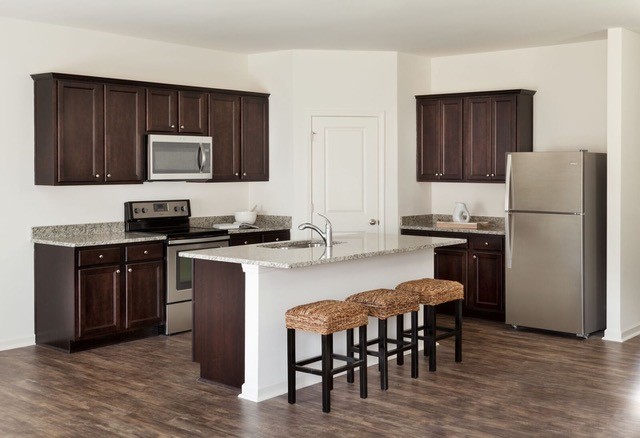Six states. Twelve markets. A reported 3,200 homes sold and recognition as Builder of the Year by Builder & Developer Magazine in 2017. A relentless, passionate commitment to design and personalization. Ashton Woods is a mid-sized builder that was in the news recently with the highlights of a national survey they conducted of 1,400 home shoppers, published in the Washington Post. I spoke with Ashton Woods’ Chief Marketing Officer, Carrie Schonberg, and its National Director of Design, Leigh Spicher, to dig into their thoughts about what the survey means for homebuilding overall.
Schonberg explained the impetus behind the survey as a desire to build on Ashton Woods’ roots as a luxury builder, their success two years ago with the launch of the first-time buyer focused Starlight Homes brand and a curiosity for understanding the market in between. The reasons behind the findings, and how Ashton Woods takes inspiration from them, reveals a company laser-focused on their vision to build homes truly inspired by the people who will live in them and to do it with a commitment to design and personalization.
All-white kitchens are now second choice
Every year, three of the most creative design minds at Ashton Woods—Jay Kallos, SVP of Architecture, Volerio Muraro, Director of Design, and Leigh Spicher, National Director of Design—travel to Milan to experience the latest design trends coming out of Europe. As a result of these insights, white cabinets falling from the top spot in the recent survey came as no surprise. Says Spicher, “I ask people, what’s your favorite color? Why not paint your kitchen island that color?”. A rise in color and a mix of materials seem to go together. Spicher continued, “we are seeing the rise of brass as a metal, mixed with brushed nickel. This mixing carries through a blend of materials and design genres, like a contemporary room with finishes that are vintage-inspired”.

The Ashton Woods Brand, Copyright Ashton Woods Homes
What’s behind this trend is a desire for authenticity and personalization. “As human beings, we aren’t all one thing. We are inspired by many things,” Spicher emphasized. Ashton Woods homebuyers begin their journey by sharing what inspires them about “home” in a design studio, where Ashton Woods designers work with them on every aspect, from backsplashes to electrical fixtures to flooring. Over coffee and conversation, they work to understand who will live in the home, and how they want to live. The designers then create three “palettes” that serve as jumping-off points for the design discussion.

Design Studio Entrance, Copyright Ashton Woods Homes
Living space is more important than bedroom size
In Ashton Woods’ survey of 1,400 homebuyers, sixty-one percent said they would trade larger bedrooms for larger living areas. The “why” behind this can best be explained as a cultural shift. Says Spicher, “We are welcoming people into our homes in ways we haven’t for years, more like our grandparents did. We’re getting together for dinner, being more neighborly, making the kitchen and family room more important. There are more extended families living together in homes, and we want to spend more time with our kids.”
Ten years ago, bedrooms with big slides and giant wall murals were the rage. Now we’ve hit pause. And homebuyers are saying: bring back the family room, where we can spend time together. Schonberg suggests a passion for authenticity may be behind this trend. “We are living our true selves, looking for connections. People are wanting to spend time together and put down the technology. We see two things, both at play. One is they want and expect a connected home and a home office with all the technology, but they also want spaces to be together with no devices, to connect as a family,” she added.
First time buyers are changing too
As CMO, Schonberg was the architect of the launch of the Starlight Homes brand two years ago, a commitment and doubling down by Ashton Woods to serve the first-time homebuyer. What are they seeing now, two years into it? “First-time buyers are all different, and it’s very hard to generalize,” she says. “There are three terms that shouldn’t be used to describe the same type of buyer: first-timers, entry-level and millennial. First-time buyers could be a young couple buying a $700,000 Ashton Woods townhome, or they could be boomers who never thought homeownership was within their reach, buying a $180,000 Starlight single-family detached home”. Schonberg says more millennials than ever are couples with good jobs and 10+ years of savings, buying at the higher end.

Entry-Level Home in the Starlight Homes Brand, Copyright Ashton Woods Homes
When the Starlight Homes brand launched, Ashton Woods expected to serve millennials, young families with kids, and young couples. “We’re seeing a lot more demographic diversity with Starlight buyers, with many in their 40s or 50s, or even older, who never thought owning a home would be their reality”. Even with these homes designed to be more attainable, all selections were made collaboratively by Muraro and Spicher, building on the company’s vision of providing good design for everyone, not just those who can afford it.
Where are trade-offs being made?
Seventy-five percent of those Ashton Woods surveyed said they were more likely to select a builder that offered design options. With attainability being near the top of most buyers’ lists, what are the trade-offs buyers are willing to make? “We encourage them to think about which rooms are most important to them,” says Spicher, suggesting investment in architectural features that are hard to change later. “We see a lot of buyers choosing flooring that’s unique, like 24 x 36-inch tiles, or cabinets and countertops with pops of color,” she continued. Most buyers realize they can update secondary bedrooms later, but it’s where they live most in the home that counts.
And what trends are ahead?
With information overload rampant in most areas of life, Spicher says she sees people going back to what’s important to them, and this feeling affects new home choices too. Post-modernism at the end of the twentieth century, with its edgy bold design and bright colors, was an answer to traditional mid-century design. “Perhaps the twenty-first century answer is a return to the authentic,” she says. “People are embracing health, time with loved ones, things with character and story. Maybe all white cabinets are too polished and lack imperfection. Bring back the grain, the story. People want to understand each other,” she continued.
Things to watch for:
- A blend of materials and design genres – contemporary and vintage go just fine together and support authenticity and tell unique stories.
- The rise of the color black – perhaps as the counter-story to the rise of the color white, or a reaction to the general environment of the news today, and a sophisticated bold choice.
- Color kitchen cabinets – buyers are more open to personal expression and sharing more of themselves in their home design.
- Homes to reflect the interests, passions and personal inspirations – for some it’s a hobby room, wine-tasting room, or yoga room, designed on purpose.
- Larger family living spaces, even in smaller homes – people crave connection and sharing time with loved one more than ever.
—Teri Slavik-Tsuyuki, principal of tst ink, brings a customer-focused “how might we?” approach to creating communities and brands that connect and engage with how people want to live their lives

